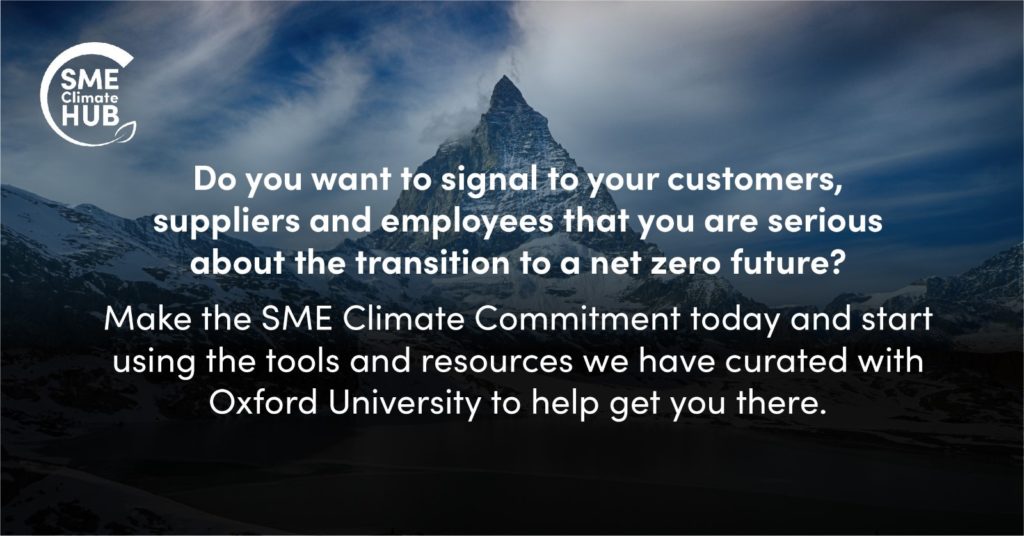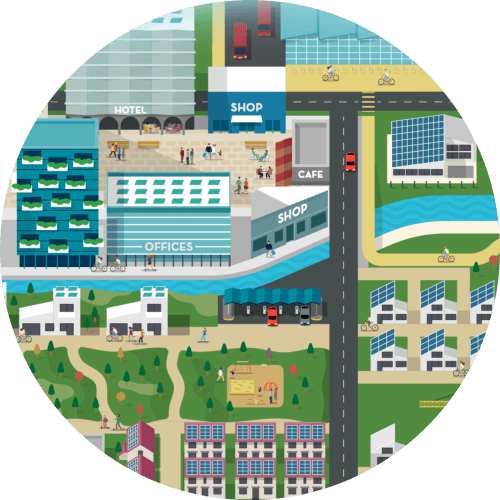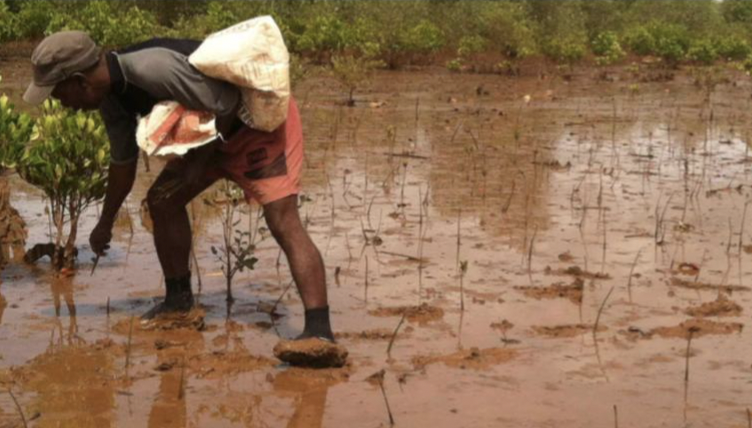Make Architecture marks 1,000th SME worldwide to commit to the SME Climate Hub
The SME Climate Hub spoke with Make’s Architect and Sustainability Lead, Oliver Hall, to hear more about their approach to climate action and how they’re leaning on the SME Climate Hub to advance their goals.
The SME Climate Hub recently passed a significant milestone: over 1,000 small businesses from around the world have signed the SME Climate Commitment, setting a goal to halve carbon emissions by 2030, and reach net zero emissions before 2050. These businesses are driving climate action across industries and geographies. They are part of the global movement of small businesses stepping up to play their part to avoid the worst effects of climate change and build business resilience along the way.
To commemorate the milestone, we spoke with the 1,000th SME to join the SME Climate Hub. Make, an international architectural practice founded in 2004, continues to be motivated by a single purpose: to design the best places, spaces, and buildings in the world. For Make, that doesn’t just mean aesthetic appeal — their design process has prioritized carbon impact since the company’s outset. One hundred projects, and 17 years later, Make shares its motivations of designing sustainably, how climate action extends across its projects, and its reliance on the SME Climate Hub as a community and resource for its efforts.
How has Make prioritized climate action previously? How do you think your commitment to the SME Climate Hub might impact your ability to take climate action or increase your impact?
As architects we’ve been focused on reducing the environmental impact of the buildings we create, focusing on passive design, waste reduction, and energy performance. One such example is the ‘death of the glass box’. We’re moving beyond the idea that offices need floor-to-ceiling glass, which contributes to overheating in the summer and significant heat loss in the winter.
Our commitment to the Race to Zero through the SME Climate Hub offers an opportunity to think beyond our day job of designing buildings and to reflect on our own spaces, how we inhabit them, and the resources we use whilst we design places for others. This exercise will undoubtedly further our understanding of all the measures that can be taken to reduce a building’s – and a business’s – carbon footprint, which we can put into practice on our projects and advocate to our clients.
Why are you acting on climate now?
Sustainability has always been important, but the level of urgency has never been quite as clear as it is now. We’re facing an existential crisis, and as architects, it’s our duty to design in ways that alleviate this threat – we must design for the health of people and our planet. That’s why our approach to sustainable development now considers the environmental, social and economic aspects of each scheme, resulting in a single, interconnected solution.
We are embracing the opportunity to influence and advocate for change on our projects, talking to our clients about what we need to do, and how we can do it, to mitigate the effects of climate change and biodiversity breakdown.
In recent years, with the climate crisis coming to the fore and the construction industry embracing the need to act on embodied carbon, our goals have evolved to commit to designing net zero carbon (embodied and operational) buildings by 2030 and to assess all projects against Make’s ‘six pillars of sustainability’ – carbon, environment, community, wellbeing, connectivity and green economy – which are linked to the UN Sustainable Development Goals. In addition, we advocate that clients target industry leading operational and embodied carbon metrics such as LETIs 2030 targets and engage in transparent reporting under ratings systems such as NABERS; Design for Performance.
Why did you make a climate commitment with the SME Climate Hub?
Far too often, organizations restrict themselves to advocacy within their own industry. The SME Climate Hub is an opportunity for cross-sector agreement which demonstrates that everyone can work together to mitigate the effects of climate change.
As the UK is set to host COP26, it’s essential we put our hands up to support positive change and collaborate with similar-sized business, showing that every organization of every size has a role to play.

What are the most common reasons holding SMEs in your industry back from committing to climate action?
Commitment can often be seen as a risk, while sticking with the status quo is viewed as a safer option that’s better for business – the thinking being that if you do commit and don’t achieve what you’ve committed to, that could damage your reputation. Of course, none of this is as big a risk as climate breakdown.
Architects are in a difficult position because our services are designing buildings for clients. Clients ultimately make the decisions, so our ability to commit needs to come from a place of advocacy and proactively educating others, whilst showing high quality architecture can be achieved in a sustainable way. Ultimately climate action is a design challenge.
We cannot make people do the right thing, so it’s important that we do all we can to sway the argument. It’s worth saying that, over the past few years, many of our clients have woken up to the climate emergency and are now proactively committing to change, with net zero carbon by 2030 becoming commonplace in project briefs.
How will your company halve emissions by 2030?
Our London studio – a space we designed for ourselves – is already net zero carbon for Scope 1 and 2 emissions. We have 100% renewable electrical supply, with passive and low-carbon space conditioning. The studio is a retrofit of an old car park, so our embodied carbon of the space is also low.
Our biggest challenge is our Hong Kong and Sydney studios; as tenants within a wider development, we cannot control the energy supply of the space. For this we will continue to advocate for change, but we need to look at certified offsetting projects, such as reforestation projects around the world or through our own tree planting in the UK. We’ve calculated that if we planted 200 trees per year, we’d be carbon neutral for that year. That would include offsetting most of our Scope 3 emissions: our international flights, landfill waste, and office sundries, in addition to the energy and heating for Hong Kong and Sydney.
What are the largest obstacles in halving emissions by 2030 for your organization and/or your industry?
As individual consumers we could all change our habits to reduce our carbon footprint overnight, but the construction industry does not have that luxury, even if everyone wanted to.
Most construction projects take many years from commission to completion. Climate action needs to happen right now, as 2030 is only one or two project cycles away for the biggest, most impactful buildings. To mitigate climate change, we need to be targeting energy efficiency far beyond current legislation and reducing embodied carbon, which isn’t even legislated for in the UK. In 8.5 years, we need to fundamentally change the way we design new buildings, upgrade a supply chain, and retrain a whole industry.
How do you think your company will benefit from taking climate action? Why do you think it’s important for other companies in your industry to do the same?
Climate action is a topic that has consequences for us all. Therefore, everyone should be educated and have a voice in how the company addresses the issue. That’s Make’s approach. Our internal working group, Make Neutral, includes representatives from across the company and projects, who act as a hub for knowledge-sharing and policy change. We think if all companies looked at it from the individual employee’s perspective, it would improve engagement and facilitate change faster.
How do you work with your clients to meet both of your climate goals?
As a practice, we’ve developed a sustainable design toolkit which explains to each architect what we should be asking our clients at each stage of the design process, from brief through to completion and beyond. The toolkit lists metrics, examples and best practices to assist in the conversation and to demonstrate how a lower-impact building can be achieved. It’s very much a collaborative effort.
Can you tell us a bit about a recent project you worked on that prioritized sustainability?
We’re currently working on the Salford Crescent Masterplan, a 102-hectare (252 acre) site, which means we are not only responding to the climate emergency, but setting the brief for future projects in collaboration with Salford City Council.
Sustainability will be at the heart of future development proposals. With the existing green assets across the area, combined with the scale of potential development, mix of uses and opportunities for delivering significant public realm improvements and a range of sustainable transport solutions, the development provides a unique opportunity to lead the way in the journey to carbon neutrality.
The objectives are very ambitious and will drive real change in the way buildings and infrastructure are designed and constructed. Net zero carbon is a key objective for Salford Crescent, and the targets set around embodied carbon and operational energy are ambitious and will require a new way of designing and constructing. However, wider sustainability objectives such as climate resilience and biodiversity are equally important.
What advice do you have for small businesses both within and outside of your industry?
The first step is the hardest. Addressing climate change and transitioning your business to net zero can look like an impossible task, but we have found that if you have the drive and empower your employees, change can happen quicker than you might expect.
Small and medium sized businesses around the world can join companies like Make and take the first step on climate action by committing to the SME Climate Hub today. For SMEs committed to the Hub that are interested in telling their own stories of pursuing climate action, please get in touch!

 Go back
Go back







